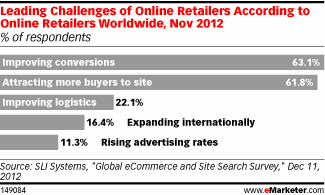In 2012, B2C ecommerce sales grew 21.1% to top $1 trillion for the first time, according to new global estimates by eMarketer. In the same report, eMarketer indicates that sales in North America grew 13.9% to a world-leading $364.66 billion in 2012, as more consumers are spending their dollars online. It is expected that this figure increases by 12.2% to $409.05 billion this 2013. If you are an online retailer, these are very exciting news.
Given this exciting outlook for online sellers, they would be tempted to think that in order to increase their sales, all that they need to do is to attract more people to their sites. While this is one part of the equation, it is not all of it.
From the SU Systems’s survey above, you can see that attracting more buyers to site is one of the two top leading challenges of worldwide online retailers. At the top of the list is improving conversions. As a digital marketer that works with several businesses that offer their products and services online, I can tell you that the optimization of a landing page or ecommerce shopping cart is often an afterthought.
No matter their size, companies often forget to optimize their customer experience. They believe that they are not selling enough because not enough people are reaching their site.
Consider this:
- Did you know that 40% of people abandon a website that takes more than three seconds to load? (Source: Rackspace)
- And, a one second delay in page load results in 7% fewer conversions? (Source: Rackspace)
- Nearly 1 in 4 online shoppers stopped short of buying because the estimated delivery date wasn’t available. (Source: Milo)
The fallacy of ever-growing online sales is to assume that yours will just grow because online sales as a whole are growing. If you’re not optimizing your site to your customers’ needs, you cannot expect your sales to increase.
To overcome major challenges—and improve on their successes—ecommerce organizations are focusing on a variety of tactics in 2013. eMarketer reported that more extensive use of A/B testing was a clear priority, with 53.6% planning to do more testing of varying pages’ effectiveness. Additional user-experience improvements to consider are adding rich auto-complete features, shorter forms, completion bars, and thumbnail preview images.
Escape the fallacy of ever-growing online sales by taking ownership of your site and start improving it.



